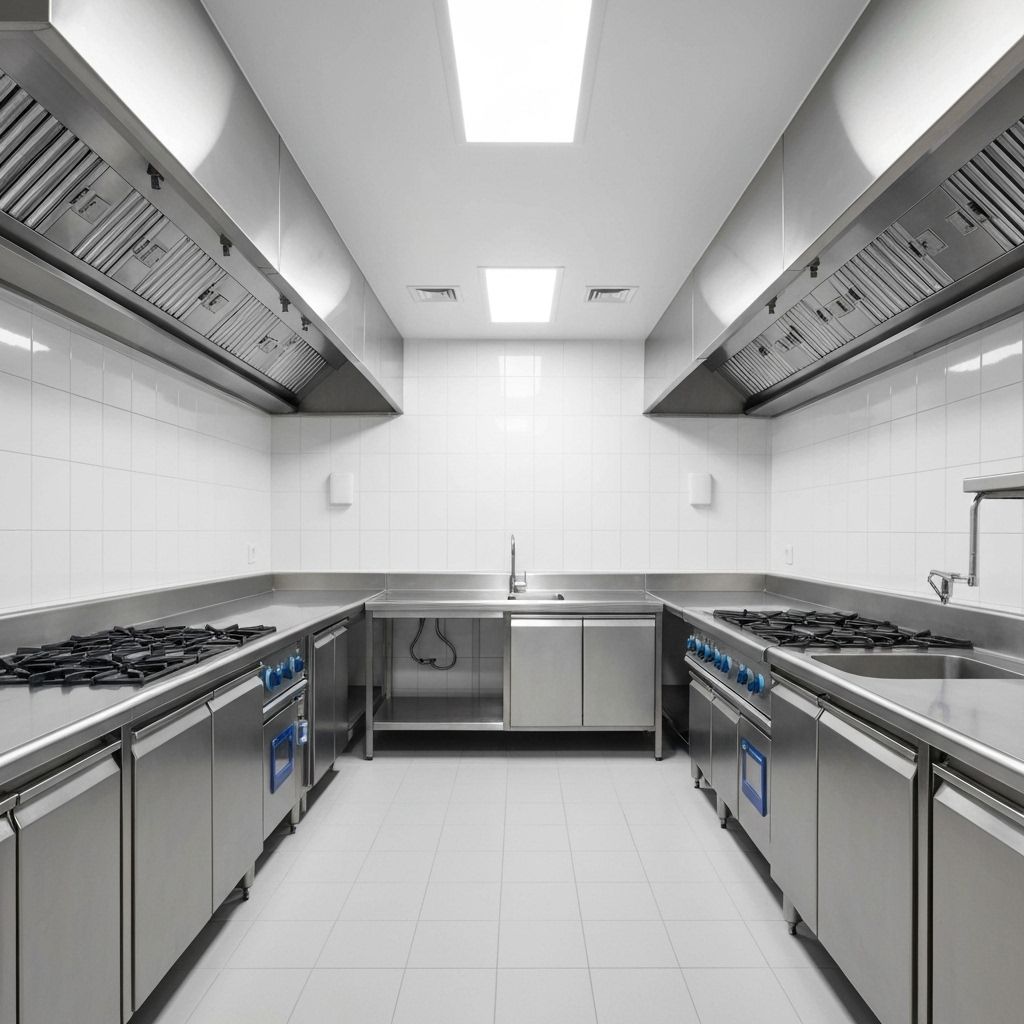
The Commercial Kitchen Wall Dilemma
When planning a commercial kitchen refurbishment or new build, one of the most important decisions you'll make is choosing the right wall covering. The walls in a commercial kitchen face extreme conditions - constant exposure to heat, moisture, grease, and aggressive cleaning chemicals. They must also meet stringent hygiene standards to comply with Food Safety regulations.
For decades, ceramic tiles have been the default choice for commercial kitchen walls. However, hygienic PVC wall cladding has emerged as a superior alternative that addresses many of the limitations of traditional tiling. In this comprehensive guide, we'll compare both options across key factors that matter to commercial kitchen operators.
Hygiene & Food Safety
Hygienic Cladding
- Seamless surface with welded joints - no grout lines for bacteria to hide
- Completely impervious to moisture and bacteria penetration
- Smooth, non-porous surface prevents bacterial growth
- Meets all Food Hygiene Rating Scheme requirements
Ceramic Tiles
- Grout lines create perfect breeding grounds for bacteria and mold
- Moisture can penetrate behind tiles through damaged grout
- Difficult to achieve truly hygienic surface due to joints
- Grout requires regular deep cleaning and eventual replacement
Winner: Hygienic Cladding. The seamless nature of welded PVC cladding eliminates the primary hygiene weakness of tiles - grout lines. Environmental Health Officers consistently prefer cladding systems because they're easier to keep clean and don't harbor bacteria.
Durability & Longevity
Commercial kitchens are harsh environments. Wall coverings must withstand impacts from equipment, constant cleaning, temperature fluctuations, and exposure to grease and steam.
Hygienic cladding typically lasts 20-25 years with minimal maintenance. The PVC material is flexible enough to absorb minor impacts without cracking, and the color is throughout the material so scratches are barely visible. The welded joints remain intact even under stress.
Ceramic tiles can last many years, but the grout is the weak point. Grout deteriorates over time, becoming stained, cracked, and porous. Even with regular maintenance, grout typically needs replacing every 5-10 years. Individual tiles can crack from impacts or thermal shock, requiring repairs.
Winner: Hygienic Cladding. While both materials are durable, cladding requires far less maintenance and doesn't have the weak point of deteriorating grout.
Installation Time & Disruption
Time is money in commercial kitchens. The faster your installation, the sooner you can start operating.
Hygienic cladding can often be installed over existing tiles, eliminating the need for demolition. A typical commercial kitchen can be clad in 2-3 days. The panels are large format, covering walls quickly, and the welding process is fast. You can often schedule installation outside operating hours to minimize disruption.
Ceramic tiles require more time. If removing old tiles, that's an additional messy process. Tiling itself is labor-intensive, with each tile individually placed. Then grout must be applied and allowed to cure. A similar-sized kitchen might take 5-7 days or more.
Winner: Hygienic Cladding. Faster installation means less downtime and lower labor costs.
Cleaning & Maintenance
Daily cleaning is essential in commercial kitchens, and your wall covering should make this task easier, not harder.
Hygienic cladding is incredibly easy to clean. The smooth, seamless surface can be wiped down quickly with standard cleaning products. There are no grout lines to scrub, and the non-porous surface doesn't absorb grease or stains. A simple wipe-down is usually sufficient for daily cleaning.
Ceramic tiles require more effort. While the tile surface itself is easy to clean, the grout lines need regular scrubbing to prevent staining and bacterial growth. Grout is porous and absorbs grease and dirt, requiring specialized cleaning products and more labor time.
Winner: Hygienic Cladding. Significantly reduces daily cleaning time and eliminates the need for intensive grout maintenance.
Cost Comparison
Initial costs are important, but you should consider the total cost of ownership over the life of the installation.
Initial Installation: Hygienic cladding typically costs more upfront than mid-range tiles, but less than premium tiles. However, the faster installation reduces labor costs.
Long-term Costs: This is where cladding really shines. With tiles, you'll face ongoing costs for grout maintenance, periodic re-grouting, and tile repairs. Cladding requires minimal maintenance beyond regular cleaning. Over 20 years, cladding is typically more cost-effective.
Winner: Hygienic Cladding. While initial costs may be similar, the lower maintenance and longer lifespan make cladding more economical long-term.
Fire Safety
Both options can meet fire safety requirements, but it's important to specify the right products.
Hygienic cladding is available in fire-rated versions that comply with BS 476 Part 6 and Part 7 standards. Always ensure your installer uses certified fire-rated materials for commercial kitchen applications.
Ceramic tiles are inherently fire-resistant, which is one of their advantages. However, the adhesive and grout must also meet fire safety standards.
Winner: Draw. Both can meet fire safety requirements when properly specified and installed.
The Verdict
For modern commercial kitchens, hygienic PVC wall cladding is the superior choice in most situations. It offers:
- Better hygiene with seamless, bacteria-resistant surfaces
- Lower long-term costs due to minimal maintenance
- Faster installation with less disruption
- Easier daily cleaning and maintenance
- Longer lifespan without deterioration
While tiles remain a viable option, especially for smaller areas or specific aesthetic requirements, hygienic cladding has become the preferred choice for commercial kitchen operators who prioritize hygiene, efficiency, and long-term value.
Making the Switch
If you're considering upgrading from tiles to hygienic cladding, the good news is that installation can often be done over your existing tiles. This eliminates the cost and mess of tile removal and speeds up the installation process.
A professional site survey will assess your current walls and recommend the best approach for your specific situation. With proper installation by certified fitters, you can transform your commercial kitchen into a more hygienic, easier-to-maintain space that will serve you well for decades to come.
Ready to Upgrade Your Commercial Kitchen?
Get expert advice and a free quotation for hygienic wall cladding installation. Our certified fitters serve commercial kitchens across Manchester, Stockport, and the UK.